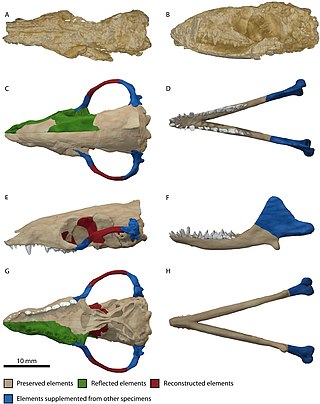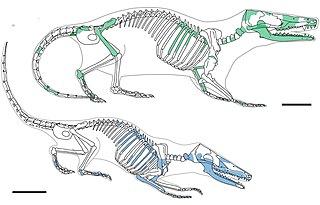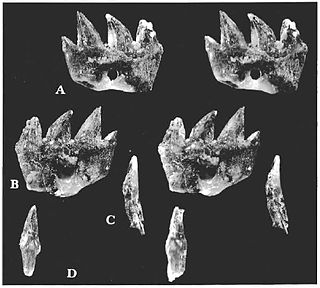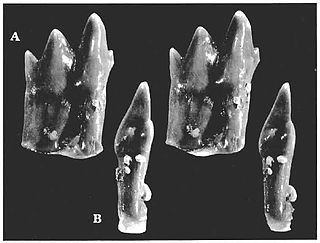
Morganucodon is an early mammaliaform genus that lived from the Late Triassic to the Middle Jurassic. It first appeared about 205 million years ago. Unlike many other early mammaliaforms, Morganucodon is well represented by abundant and well preserved material. Most of this comes from Glamorgan in Wales, but fossils have also been found in Yunnan Province in China and various parts of Europe and North America. Some closely related animals (Megazostrodon) are known from exquisite fossils from South Africa.

Docodonta is an order of extinct Mesozoic mammaliaforms. They were among the most common mammaliaforms of their time, persisting from the Middle Jurassic to the Early Cretaceous across the continent of Laurasia. They are distinguished from other early mammaliaforms by their relatively complex molar teeth. Docodont teeth have been described as "pseudotribosphenic": a cusp on the inner half of the upper molar grinds into a basin on the front half of the lower molar, like a mortar-and-pestle. This is a case of convergent evolution with the tribosphenic teeth of therian mammals. There is much uncertainty for how docodont teeth developed from their simpler ancestors. Their closest relatives may have been certain Triassic "symmetrodonts", namely Woutersia, Delsatia.

Volaticotherini is a clade of eutriconodont mammals from the Mesozoic. In addition to the type genus Volaticotherium, it includes the genera Argentoconodon, Ichthyoconodon, and potentially Triconolestes.
Shuotherium is a fossil mammaliaform known from Middle-Late Jurassic of the Forest Marble Formation of England, and the Shaximiao Formation of Sichuan, China.
Amphilestes is a genus of extinct eutriconodont mammal from the Middle Jurassic of the United Kingdom. It was one of the first Mesozoic mammals discovered and described.

Triconodontidae is an extinct family of small, carnivorous mammals belonging to the order Eutriconodonta, endemic to what would become Asia, Europe, North America and probably also Africa and South America during the Jurassic through Cretaceous periods at least from 190–66 mya.
Amphilestidae is a family of Mesozoic mammals, generally regarded as eutriconodonts. They may form a paraphyletic or polyphyletic assemblage, though they share with gobiconodontids their similar tooth occlusion patterns and may be especially closely related to them. They occur from the Middle Jurassic to Cenomanian, and have a distribution across Laurasia.
Paritatodon is an extinct mammaliaform which existed in Kyrgyzstan and England during the Jurassic period. It was originally the holotype specimen of Shuotherium kermacki, but Martin and Averianov (2010) argued that it resembled the genus Itatodon (Docodonta) and so renamed it Paritatodon.
Argentoconodon is an extinct genus of theriimorph mammal from the Cañadón Asfalto Formation of the Cañadón Asfalto Basin in Patagonia. When originally described, it was known only from a single molariform tooth, which possessed a combination of primitive and derived features. The tooth is currently held in the Museo Paleontológico Egidio Feruglio, where it was given the specimen number MPEF-PV 1877. New material described in 2011 show that Argentoconodon was similar to Ichthyoconodon, Jugulator and Volaticotherium within the family Triconodontidae, and possibly also Triconolestes.

Ichthyoconodon is an extinct genus of eutriconodont mammal from the Lower Cretaceous of Morocco. It is notable for having been found in a unique marine location, and the shape of its teeth suggests an unusual, potentially fish-eating ecological niche. Analysis suggests it is part of a group of gliding mammals that includes Volaticotherium.

Dyskritodon is a genus of extinct mammal from the Early Cretaceous of Morocco, and possibly the Early Jurassic of India. Of uncertain affinities, it is tentatively described as a eutriconodont.

Phascolotherium is a genus of extinct eutriconodont mammal from the Middle Jurassic of the United Kingdom. Found in the Stonesfield Slate, it was one of the first Mesozoic mammals ever found and described, although like the other mammal jaws found at the same time, it was mistakenly thought at first to be a marsupial.

Borealestes is a genus of docodontan from the Middle Jurassic of Britain, first discovered on the Isle of Skye near the village of Elgol. It was the earliest mammaliaform from the Mesozoic found and named in Scotland. A second species and was later found in other Middle Jurassic sites in England, but is now shown to be a different genus. A new species, B. cuillinensis was named in 2021, also from Skye.
Wareolestes rex is a mammaliaform from the Middle Jurassic (Bathonian) rocks of England and Scotland. It was originally known from isolated teeth from England, before a more complete jaw with teeth was found in the Kilmaluag Formation of Skye, Scotland.

Palaeoxonodon is an extinct genus of cladotherian mammal from the Middle Jurassic of England and Scotland.
Peraiocynodon is an extinct mammaliaform from the order Docodonta, found in the Middle Jurassic rocks of the United Kingdom. It is only known from isolated molar teeth found in the mammal bed at Kirtlington cement quarry in Oxfordshire, England.
Cyrtlatherium is a dubious genus of extinct docodontan mammaliaform from the Middle Jurassic rocks of Oxfordshire, England. As it is only known from a few isolated molar teeth, there is disagreement about whether Cyrtlatherium is a separate genus, or whether it is a synonym and the molar teeth are the deciduous teeth of another genus of docodont.
Krusatodon is a genus of extinct docodont mammaliaform from the Middle Jurassic of the United Kingdom. It is known from remains found in the Forest Marble Formation and also from the Kilmaluag Formation on the Isle of Skye, Scotland.
Cherwellia is an extinct genus of mammaliaforms, possibly belonging to Morganucodonta, that lived in what is now England during the Middle Jurassic. The type and only known species is Cherwellia leei. It was first described in 2016 by Percy M. Butler and Denise Sigogneau-Russell from a single lower molar found at the Kirtlington Quarry of the Forest Marble Formation.
Dobunnodon its an extinct genus of docodont from the Middle Jurassic (Bathonian) Forest Marble Formation of England, first discovered in Oxfordshire near the village of Kirtlington. The type species, D. mussettae, was originally named as a species of Borealestes in 2003.












